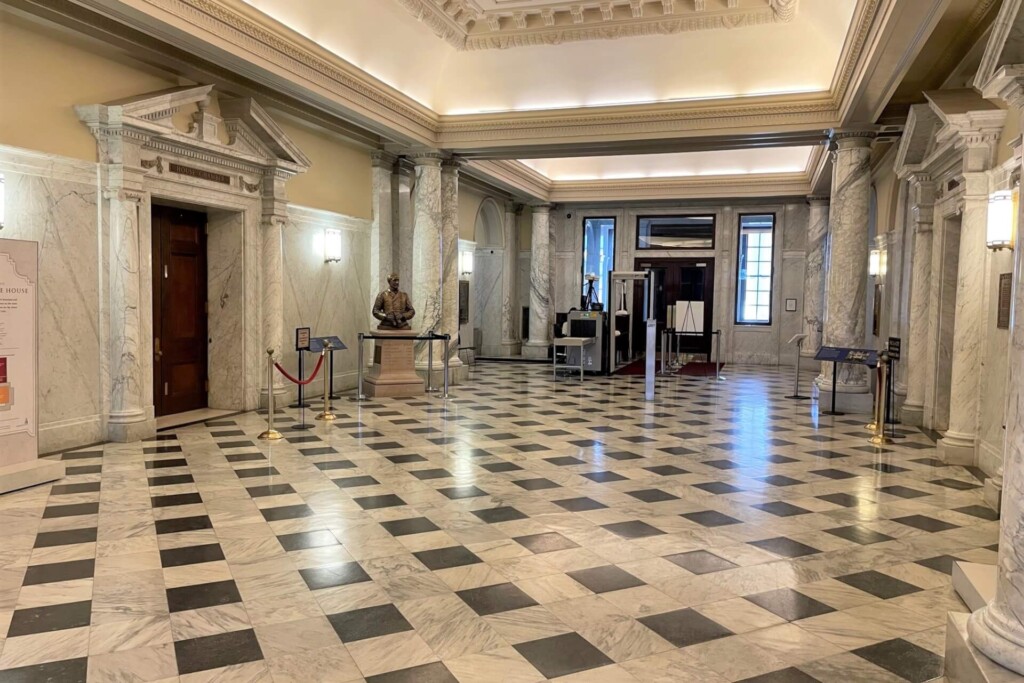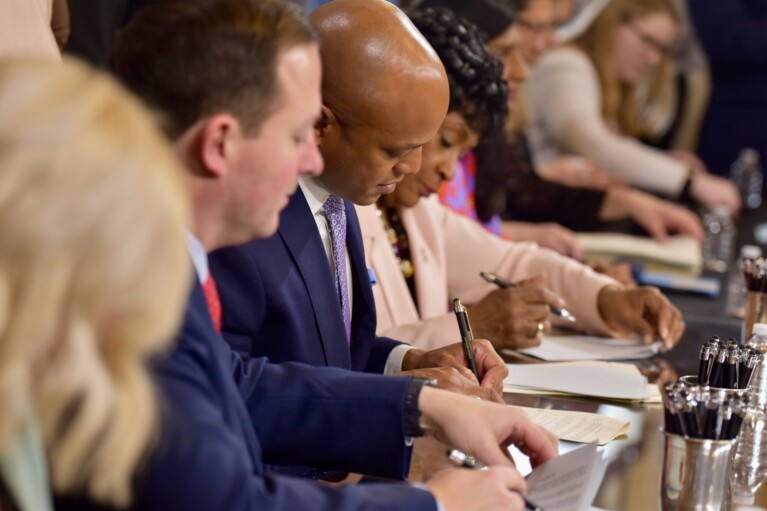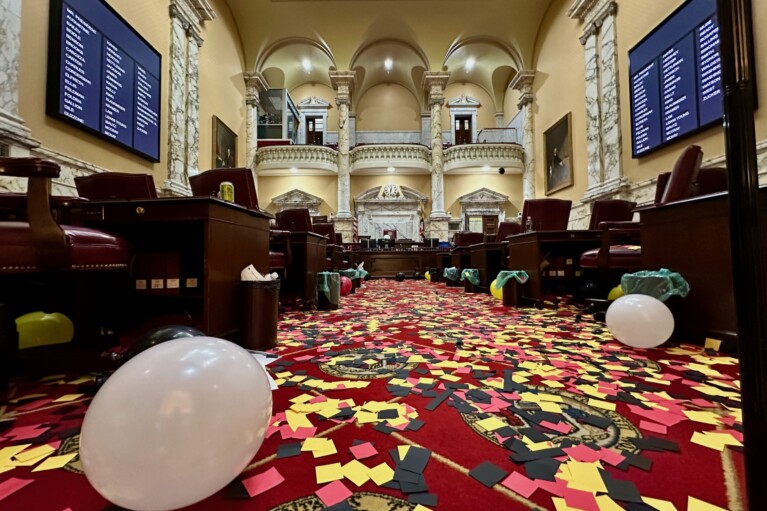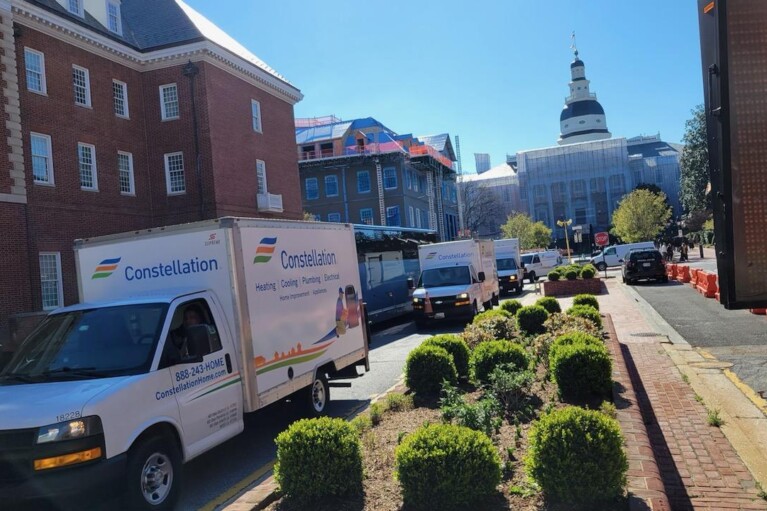Get Ready for General Assembly Session 2.0: Protocols and Schedules to Change

The second phase of the 2022 General Assembly session starts Monday.
After five weeks of virtual hearings and a limited number of floor sessions — especially in the House, which has met in full just three times since the session opened on Jan. 12 — the legislature is getting closer to a semblance of normalcy, two years after the COVID-19 pandemic ended the 2020 session abruptly.
Beginning Monday, all Senate committee hearings will be held in person, and the full Senate will have floor sessions almost every day. House hearings will remain online, but the full House will begin holding regular floor sessions this week.
Senate leaders have cast their decision to move to in-person hearings as a welcome return to business as usual, and a hopeful sign that the omicron variant is steadily waning.
“We can get back to our more traditional way we have done our work,” Senate President Bill Ferguson (D-Baltimore City) told his colleagues last week. “I think we’re going to have to figure out how to live safely with this virus,” he added.
But for members of the public, and for lobbyists and advocates who seek to influence legislative outcomes, the change in routine will require some significant adjustments.
“Advocacy will absolutely look different now that the Senate is resuming in-person hearings and the House of Delegates will be back for floor sessions,” said Brian Frazee, president of the Maryland Government Relations Association. “I expect that you will see a lot more people around the State House complex, including lobbyists.”
One lobbyist joked that after two years of Zoom meetings and online hearings, where he could participate in casual clothing, he would have to “get my pants to the dry cleaners.”
The public has largely been physically absent from the legislative process since the legislature cut its 2020 session short during the early wave of COVID-19 — and lobbyists have all but been absent, too. Last year, the public was banned altogether from the State House and other legislative buildings. This year, the public has access to the buildings, and advocates have been allowed to visit lawmakers in their offices on a limited basis, but there haven’t been many people around to this point, especially with many House members largely working from home.
When the legislature set up virtual hearings beginning in the spring of 2020, General Assembly leaders and many advocates argued that the legislature was becoming more accessible in a way, that members of the public could provide testimony on pressing matters from the comfort of their homes, without having to take significant time off to travel to Annapolis. For lobbyists, lawmakers’ cell phone numbers, rather than physical proximity or an ability to wine and dine legislative committees and delegations, became a prized possession.
The legislature also became more transparent about some of its operations. Committee hearing calendars for the first time listed bills in the order they would be heard. And, most significantly, committee voting sessions were livestreamed for the first time, with a list of bills to be considered at the voting sessions listed online in advance. In the past, those voting sessions were shrouded in mystery, with little advanced warning about what bills would be taken up.
But with in-person hearings returning to the Senate, some advocates and good government groups are wondering whether some of the newfound transparency will be diminished.
Late last week, more than 150 advocacy organizations wrote a letter urging Ferguson to maintain the option for virtual testimony for the rest of the session.
“This change democratized the previous system that by design only provided access to those who have the privilege, flexibility, and resources to participate fully in Maryland’s legislative process,” the groups wrote. “The ability to provide oral testimony online has made participation possible for those who live far from Annapolis or who do not have access to transportation; hourly workers, who can’t afford to take a day off of work; caregivers, who cannot leave children or other loved ones alone; and those who are homebound for numerous reasons.”
Victoria Venable, Maryland director of the Chesapeake Climate Action Network, said it is important to have virtual options for those who do not have the flexibility to drive to Annapolis to testify on a bill.
“One of the few good things that came out of the COVID pandemic was realizing that there were opportunities to have more accessible hearings and more accessible connections to our legislators,” she said. “I hope we don’t leave those changes behind.”
The Senate president’s office responded to the advocacy groups with a brief statement: “From the beginning of the 2022 Legislative Session, the Senate President has believed that a core part of the democratic process is having the public in person when safe to do so. Key health metrics are returning to pre-omicron levels, and as such, the Senate President is moving forward with the plan. After careful consideration of many perspectives, the Senate resumes in-person testimony, with masking, beginning Monday, February 14. Voting sessions will be live-streamed, and the public may submit written testimony electronically if they cannot participate in a hearing.”
‘We may as well make the best of it’
Several senators said they are excited to return to in-person hearings.
“I’m glad to get back to normal,” said Senate Budget and Taxation Committee Chair Guy J. Guzzone (D-Howard). “Most people are, I think.”
Sen. Michael J. Hough (R-Frederick) said he missed typical work habits like getting printed copies of bills to mark up and refer to during hearings. Conversation can also flow more freely during bill hearings and committee discussions in person, compared to video calls.
“It’s been very depersonalized,” Hough said.
Video proceedings also lacked a sense of gravity or formality that can come with holding meetings in person and engaging with witnesses, who are often telling deeply personal stories to his committee.
But Hough said he was disappointed that the Senate will continue to livestream committee voting sessions, which were historically quite blunt in part because they weren’t broadcast.
The Judicial Proceedings Committee, in particular, discusses bills of a controversial and sensitive nature, and livestreaming the debate “is just going to inhibit conversation,” he said.
During their floor sessions in 2021, senators sat in plexiglass pods and when they met together in their committee rooms, plexiglass separated them from their neighbors. Those barriers and pods have been taken down, and now these lawmakers will be in close proximity to members of the public — and each other — with increasing frequency. Four of the Senate’s 47 members are in their ’80s, and nine are in their ’70s.
One of the octogenarians, Sen. Obie Patterson (D-Prince George’s), who is 83, said he takes comfort in knowing that some of the COVID-19 protocols are remaining intact, even as in-person hearings are about to commence.
“It was something that was going to happen sooner or later, so we may as well make the best of it,” he said.
In the House, which has three times as many members as the Senate, leaders have been more circumspect about asking their members to meet in person. Last year, for floor sessions, delegates were evenly split between the House chamber and a “chamber annex” in a House office building across the street. This year, the full House meets on the chamber floor, though a handful of delegates have been sitting in the gallery overlooking the chamber. Some lawmakers believe that keeping the hearings virtual is one way to protect the health of members — and the public.
“This may not be a popular opinion, but I like the Zoom hearings,” said Del. Jennifer R. Terrasa (D-Howard). “They’re a good way for family people, for working people, to participate in the process. And from my perspective, it’s a safe way to go. It just feels safer, not to be stuffed in a room with a bunch of people.”
‘Any return to normalcy is a good thing’
Several advocates said simultaneously monitoring and participating in in-person Senate hearings at the same time they’re following or testifying in remote House hearings will be the latest logistical test of the pandemic.
“The inconsistency in formats between the House and Senate will be the biggest challenge, especially when you have a bill being heard in both chambers on the same day,” Frazee said. “That will be particularly hard for those who do not have office space in Annapolis.”
Venable said for environmental groups, Tuesday will present the first challenge, when the sweeping Climate Solutions Now legislation is up for a hearing in the Senate, while other environmental bills are being heard in the House.
“We’re trying to balance — where are we going to take our virtual hearings, when do we have to be in person for the Senate?” she said.
But lobbyist Sushant Sidh, a partner in the firm Capitol Strategies LLC, noted that lobbyists have always had to balance their time between House hearings and Senate hearings, and committees have often been accommodating, so the new logistical challenges won’t be much different.
Sidh said he and his colleagues are pleased to move beyond “the nonpersonal lobbying” of texts and phone calls. “It’s so much easier when you can steal someone’s glance across a hallway.”
And several lobbyists said simply being able to read the body language of a committee during hearings is an invaluable part of the profession that’s been missing during the pandemic.
“I understand the sensitivities with COVID,” Sidh said. “But any return to normalcy is a good thing.”
Elizabeth Shwe contributed to this report.





 Creative Commons Attribution
Creative Commons Attribution